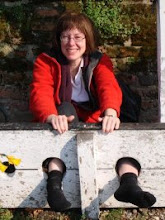



I had an email from Clare C - she says "Took a quick look at the blog and noticed the pink and gold Llanelli quilt. What a find! I was very interested to see the strange compound flowers in the outer border. The central rose is very familiar, but I have only seen the rather unusual "claw like" petals/leaves in much older quilts from Pembrokeshire. The Quilt Association has a super example, with a five armed starfish on it too. So I have always thought of them as "crab claws".
The quilt she is talking about is of course the Starfish quilt - a floating centre diamond quilt shown in the book Making Welsh Quilts - I was pleased to see this "in the flesh" when we went up to Llanidloes for the Sykas workshop on fabric dating. Each member of the Quilt Association was invited to choose a quilt to research - and Susan L. did not know which quilt to choose. To her surprise, she was assigned the Starfish quilt! As there was a bit of time to spare at the workshop, while Phillip was there the quilt was brought out for us all to look at - Phillip was able to tell us that it is not cotton as previously thought, but wool worsted cloth of a fine quality, and older than previously thought. The thread is round, so dates after 1830. It is handsewn, with a linen twill backing. The quilt has never been washed although there was some water and a little moth damage to be seen (apparently moths do not like clean items). Probable date from several lines of reasoning - 1830 - 1850. The wadding is fine carded wool. I was most impressed with Phillips handheld digital microscope, it was very useful for looking at details of thread and fabric.
Susan and I had wondered at the time whether the crab claw was correct - there is no provenance to the quilt, but it has always been assumed to have a maritime connection, hence the assumption of starfish and crabs claws - I think they look more like stylized tulips or flowers myself.
I can say that the Sykas workshop on fabric dating was the best and most thorough that I have been to - a real eye opener with a fabric academic - if you do not have a copy of The Secret Life of Textiles I would recommend it (now out of print but copies still available I think). There is also a brochure by Phillip available to download at:
Or, go to http://www.dress%20and%20textiles%20speicalists.org.uk/, go to Resources and look for Identifying Printed Textile Booklet. There are also booklets on Woolen textiles and lace.
I also have transcribed my notes from the two days and find these a good resource to look back upon - I wish Philip would write a book about dating British/English fabrics - Britain produced most of the world's fabrics and flooded world markets so such a book would be useful everywhere. Sadly, the textile industry that produced so much of Britain's wealth, was never protected by the government and has now all but disappeared.

No comments:
Post a Comment